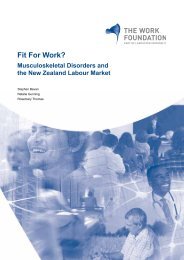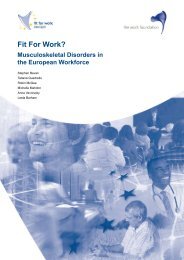FfW Bulgarian report (English language) - Fit for Work Europe
FfW Bulgarian report (English language) - Fit for Work Europe
FfW Bulgarian report (English language) - Fit for Work Europe
You also want an ePaper? Increase the reach of your titles
YUMPU automatically turns print PDFs into web optimized ePapers that Google loves.
presented in the Table 3.3 below. The reasons <strong>for</strong> incapacity are also somewhat limited and do<br />
not include recognised occupational diseases from the list developed by the NSI, indicating a<br />
lack of standardisation in recording disease across government departments.<br />
Table 3.3. Days lost and costs resulting from temporary inability to work<br />
Reason 2008 2009 2010<br />
Damage to intervertebral disks in<br />
the neck region<br />
Damage to intervertebral disks in<br />
other regions<br />
Damage to nerve roots and<br />
plexuses<br />
Dislocation, strain or sprain of knee<br />
joints and ligaments<br />
Dislocation, strain or sprain of foot<br />
or ankle joints and ligaments<br />
Cost<br />
min<br />
BGN<br />
Number<br />
of days<br />
lost<br />
Cost<br />
min<br />
BGN<br />
<strong>Work</strong> and MSDs in Bulgaria<br />
Number<br />
of days<br />
lost<br />
Cost<br />
min<br />
BGN<br />
Number<br />
of days<br />
lost<br />
– – – – 1.25 55,497<br />
10.23 256,529 11.38 533,337 6.9 319,936<br />
8.85 483,826 13.92 613,578 10.45 455,309<br />
2.99 143,225 4.47 125,644 3.66 140,324<br />
2.0 99,827 2.69 114,532 2.09 87,898<br />
Inter-articular knee joint damage – – 2.28 115,494 2.60 99,957<br />
Source: NSSI (2011b)<br />
Similarly the methods of collecting sickness absence data in organisations have limitations. For<br />
example with the self-<strong>report</strong>ed surveys, employees might <strong>report</strong> sickness on days when they<br />
were not due to work anyway. With employer surveys the responses are limited by the quality of<br />
the absence records employers keep (<strong>for</strong> example, employees do not always record absence<br />
accurately or categories <strong>for</strong> recording causes are not adequate). This is partially due to the low<br />
awareness of the impact of ill health on work. Employer surveys are also subject to response<br />
biases where only organisations with good methods to measure absence are likely to be able<br />
to respond quickly to the survey request. In all cases records and <strong>report</strong>s are subject to biases.<br />
Managers, <strong>for</strong> instance, tend to under<strong>report</strong> their own absence.<br />
Not only are indirect costs associated with sickness absence and presenteeism, but indirect<br />
costs are also associated with early retirement among people with MSDs (Dagenais et al.,<br />
2008; Alavinia and Burdorf, 2008). However, these figures still underestimate the true cost of<br />
conditions such as MSDs. Most people with MSDs (even those with diagnosed conditions)<br />
continue to work (Waddell and Burton, 2006a), experiencing emotional distress of fearing to<br />
<strong>Fit</strong> For <strong>Work</strong>? 39







